| Author | Message | ||
| lbpesq
Senior Member Username: lbpesq Post Number: 6400 Registered: 7-2004 |
I've been reading about the Earvana compensated nut. Anyone around here ever tried one? Thoughts? Bill, tgo | ||
| edwardofhuncote
Senior Member Username: edwardofhuncote Post Number: 913 Registered: 6-2014 |
I have not tried the Earvana one, but Stelling Banjo Works here in Virginia has used a compensated nut for years. I get *how* & *why* it works, and I'm fascinated that someone finally figured out how to compensate for the intonation problems from fret height. Probably a great idea for electric guitars, but you lose the benefit if you ever use a capo. (which I suppose is why someone invented those crazy squiggly frets) | ||
| ed_zeppelin
Advanced Member Username: ed_zeppelin Post Number: 320 Registered: 2-2010 |
I spent some time at the Earvana booth at NAMM, and even in that infernal racket you could hear that it really worked. I've also spent some time at a Taxi Road Rally with Buzz Feiten. To be clear, there were about thirty other people, and Skunk Baxter was demo'ing the Buzz Feiten "system" so it wasn't like anybody was trying to yank the guitar out of his hands. ("C'mon, man! Let me try it! I've almost got "Sweet Child of Mine" dialed in!") But I heard it with my own eyes, and it works. The reason for the distinction is because I honestly think they sound the same (gasp!). Because they do the same thing: they make the nut reflect the saddles. Buzz told me/us that personally/collectively. Imagine putting a mirror at the 12th fret and looking at the saddles, then turning it around and looking at the nut (sounds naughty, don't it?) the more you can make them resemble each other, the more fighting chance each string has of compensating for our deeply-flawed "equal" temperament. The saddles on every Strat are in the same place, or at least should be. Here's a very groovy picture of David Gilmour's:  Less artistic but way more informative is this example, courtesy of the internet, which is never wrong: 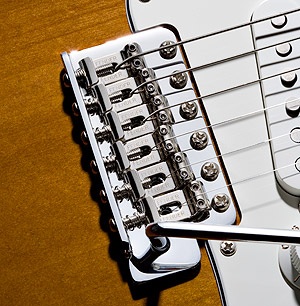 A very cruel man named Floyd Rose taught me about the discrepancy between the D and G. The "unsolvable equation." They're right in the middle of everything, side by side, one's a 5th of the other and the other is a fourth of the ... well, you know what I mean. You'd think they'd be friends, but no. The Floyd Rose bridge required elaborate rituals involving tiny parts and mysterious incantations to adjustment the saddles just a hair (you know what kind), but if any of the parts showed the slightest wear it had to be replaced. It was a musical form of water-boarding, and all so Junior could do his best Eddie Van Halen dive-bombs for the neighborhood(s). I didn't understand why until I saw Buzz Feiten explained the mirror thing. His nut has undergone revisions over time (so has mine), but here are some examples: 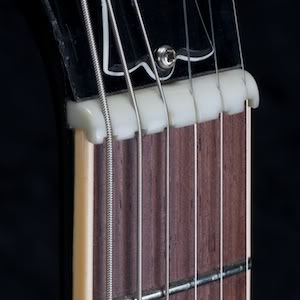 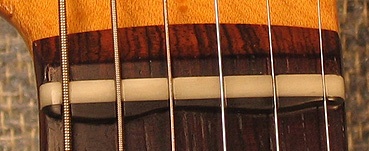 David Gilmour's Strat(s): 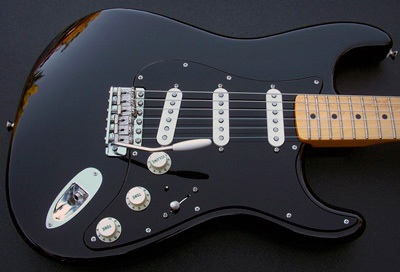 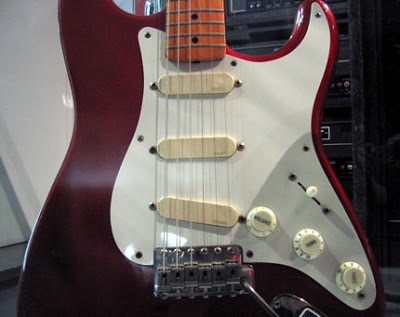 Earvana: 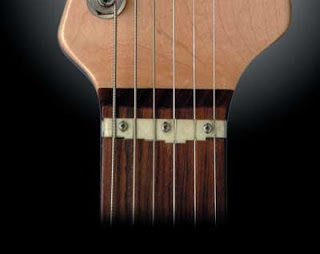  See? Greg knew I wanted to trot out the squiggly frets, but I think it's the greatest visual aid to understanding the wrestling match between the three factors involved in playing "in tune" and what a loose concept that actually is (Blame JS Bach. It's his fault, and Greg will back me up on that.)  Finally, a visual explanation of the discrepancy between the D and G saddle positions. It just never occurred to me that the saddle positions were trying to compensate for something happening at the "House of the Rising Sun" end of the neck. I think it's called first position (I think of it as "around the first two dots"). The only straight fret is at the octave, and the farther away from the octave in either direction, the wonkier the tuning - but the more you try to compensate by changing the length or position (by saddle or compensated nut), the more it changes things somewhere else. The "E-centric" nature of equal temperament is apparent in the fact that the frets for both E strings are pretty much the same, and their frets seem least prone to squiggliness. By that I mean they're in the same place as unsquiggled guitars. It's an mystery in a taco shell, wrapped in a soft flour enigma. Or something like that. I should ask Jimmy Johnson to explain it, the next time the subject of temperament comes up. His father was a piano tuner, y'know. Sorry I lost my temper. (I'll ask the Foghorn for a compensated nut. That usually does the trick.) | ||
| jalevinemd
Senior Member Username: jalevinemd Post Number: 1092 Registered: 12-2003 |
I honestly find all of this very interesting. And it still amazes me, even after all of these years of playing, how little I know about the physics and mechanics of my guitars. Yet I still wouldn't go out and purchase any of these products. Wondering how many would? I guess if these imperfections weren't trouble enough for the people who've brought me the music I love, they're not trouble enough for me. Let's face it...maybe nuts and saddles weren't meant to live together in perfect harmony. Just ask any cowboy. | ||
| gtrguy
Senior Member Username: gtrguy Post Number: 1042 Registered: 9-2004 |
It seems to me that as soon as you fretted a note, all the tweaking at the nut would not do anything. is this just for playing open chords or notes? | ||
| lbpesq
Senior Member Username: lbpesq Post Number: 6404 Registered: 7-2004 |
Fretting and capoing, (is there such a word?), do not remove the effect of the compensated nut because the compensation changes the tension on each string. The amount of tension remains constant, even when fretting or using a cheater, (umm, I mean, "capo"). I'm thinking of trying one of these on a new Franken-build I'm considering. Bill, tgo | ||
| edwardofhuncote
Senior Member Username: edwardofhuncote Post Number: 914 Registered: 6-2014 |
Knowing how the magic trick works takes a little bit of fun outta' the show. Compensated frets, nut, saddles... there's a minimum requirement for an instrument to be considered "playable" by any competent player with just enough skill. It's probably a different spot for each of us, but I draw the line way before a compensated nut. Believe it or not, the modded nut is also compensating for the length of the string *behind* the fret being noted. The slight tweak to intonation is so miniscule that a player like me wouldn't have a practical use for the difference. Here's the secret - don't press the strings down any harder than absolutely necessary to achieve a clean note, and you'll never miss a compensated nut. Frets are the scourge, indeed the bane of perfect intonation. They are real troublemakers. The world of stringed instruments was doing just fine until some luthier (maker of lutes) came along trying to make stuff easier with little bits of wire placed at intervals, thus turning a fingerboard into a fretboard. If I have a point, it's this - there simply are much more important factors, and effective adjustments, starting with an obvious one that gets overlooked a lot. Here's a little homily from the workbench of my cussin' cuzzin' Cletus D. Hack. Mandolins (close relative of cursed lute) have four pairs of strings, each course tuned in unison. Guess what happens when the nut slots of one course are a couple thousandths off matching each other? Your brain will say "wow, this thing sucks, it won't play in tune at all. But why? The strings are perfectly in tune, the bridge is perfectly placed, so that the octave harmonic is dead-on, or so sayeth the chromatic tuner. What's the x-factor? Having to press one of those strings down further to get that clean note, whether it's on the first fret or the next, makes it note sharper. Whether it's a guitar, mandolin, or a lute, (or even an Alembic bass) the nut slots have to be cut so that the bottom of the strings barely clear the top of the first fret. Too low and it rattles, too high and it intonates sharp. My head hurts. And I have a gig in 15 minutes. Thank goodness on a fretless bass. | ||
| cozmik_cowboy
Senior Member Username: cozmik_cowboy Post Number: 2025 Registered: 10-2006 |
I have not had the system explained to me by Mr. Feiten, but as IIUC the compensated saddle only does it's thing when the setup is sweetened - a formula the Buzzster worked out wherein this stirng's fretted & harmonic octaves are off by X cents, the next by Y cents, etc. Haven't heard any of these - I hope I would hear the difference, but my ear is pretty fair and I must admit I don't hear the problem. I have a suspicion the main intended compensation is from pickers to inventors........ Peter |